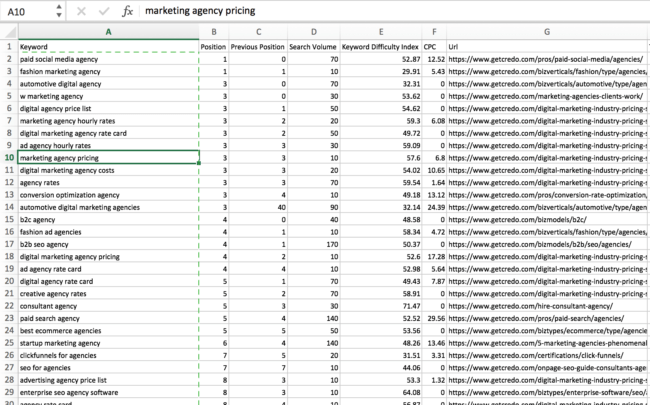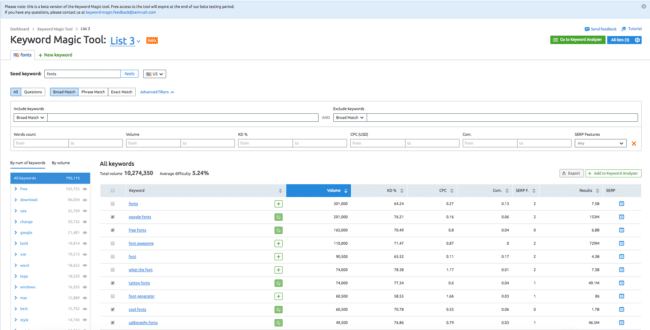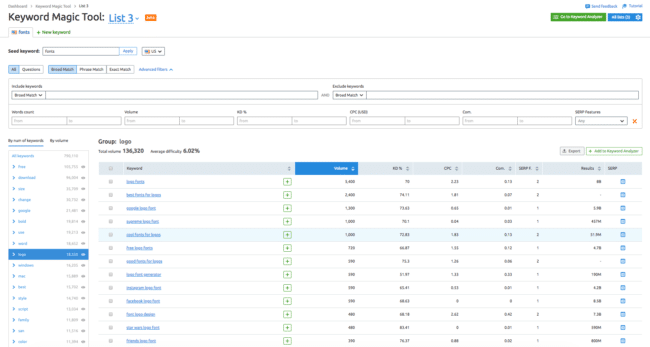Did you know that SEMrush has a database of over 5.8 billion keywords worldwide, with 780 million keywords alone in the United State and 647 million in Brazil? This keyword database is a valuable resource as you do keyword research for your business or your clients.

In this article we will talk about using SEMrush for keyword research, including:
Credo is a SEMrush affiliate, and because of that they’re offering you a FREE 14 day trial when you use our exclusive link.
One of my favorite ways to use SEMrush is finding my own organic ranking opportunities on my own website, or for clients. Oftentimes the biggest wins you can have on a site are not for one specific keyword, but for a bucket of keywords. With search engines, especially Google, doing a much better job these days of identifying topics and where a website is relevant for a specific topic (and thus rewarding those sites), a single URL can rank for many high volume queries.
This is the best way I know to identify the keywords that you are already ranking for but are not driving you traffic. By identifying them, you can then build your strategy to rank better for them which is usually some combination of:
When I did this on Credo, our traffic to our major pages doubled in about a month and since that point has increased 4x, so you know this works:

To identify these keywords, go to SEMrush and enter your domain:

Then click the Organic button to go to the organic-only view:

On this page you will see your keywords sorted by the highest ranking. While those are good to know, you’re not going to get more traffic from them (without title tag optimization, maybe getting featured snippets or answer boxes, etc). You can’t improve their rankings.
Instead, let’s identify the keywords that are ranking 5+ and thus are candidates to improve rankings and drive (more) traffic. To do this you should filter down to these using the filters provided on the page:

This gets really fun when you expand this to keywords on page 2 (anything greater than 10) because this shows you the keywords that definitely are not driving you meaningful traffic yet if you do move them to page 1, and at least half way up page 1, you can drive meaningful traffic and revenue to your business. I have some big opportunities:

From here I recommend downloading the keywords using SEMrush’s Excel/CSV export option to save for later:

We’re just getting started.
Now that you have your seed list of keywords that you are already ranking for according to SEMrush, it’s time to expand your keywords so that you can identify if you can build out a better information architecture to target new keywords that make sense for your business around the same topic.
We’re going deeper into their database by clicking into a specific keyword. This works great when you have a specific topic that you would like to dive deeper into, such as ecommerce.
You’ll be taken to a page like this, which for me I chose [best ecommerce agencies] since I rank #5:

Then click into Related Keywords to see all of them (in this case, over 600!):

Download the keywords as shown above and repeat for your other main queries, whatever those may be for your business.
To take action on these, have a read of our Information Architecture for SEO guide.
Another great way to discover brand new keyword opportunities for your site is through competitor analysis. SEMrush gives you insight into your competitors and what they are ranking for, as well the ads that they are currently buying, the ad copy they are using, and the keywords they are bidding against in Google Ads.
Let’s say that you are a luxury men’s sneakers brand wanting to break into the US market with your comfortable leather-upper sneakers that are competitively priced. You know that Greats (Credo has no affiliation) is a well known brand, so you want to see how well they are ranking:

As before, click on Top Organic Keywords to see all of the keywords for which the site ranks organically:

This next step is important if you are investigating a competitor that has a large branded following, like Greats. You need to remove their Branded keywords from the report so that you are only left with the non-branded.
One caveat here is if you want to use a strategy where you target keywords like [*brand* alternatives] which for bigger brands can have a lot of search volume.

Do this for each competitor that you want to investigate and download their keywords.
Then, create a spreadsheet that has the following worksheets on it:

Following the instructions within that sheet, you can determine where your competitors rank but you do not.
You can download our spreadsheet example here.
SEMrush has the concept of “Projects” where you can track websites and certain things like technical opportunities, brand mentions, keyword rankings, and more:

At the current moment there is not a direct way to select a set of keywords and directly add them to your Project, so there is a workaround that you can use.
Go to your site’s organic page on SEMrush (something like https://www.semrush.com/info/getcredo.com) and filter down on the keywords, then click Export and “Export All”, or as many as you can according to your plan:

This will download a file that you can open in Excel or Google Docs:

Then, copy the keywords and paste them into the Position Tracker within your project:

While it would be nice to have a more seamless process than this from the keyword filter list to a project (much like Moz’s Keyword Explorer does), I do like this process because you can download your list and clean it in Excel, then upload and apply tags across that specific keyword set.
This serves the purpose of keeping your data well segmented so you can track ranking changes across buckets of keywords as you continue to optimize your website.

Finally, there is one more tool currently in the SEMrush toolset for keyword research – the Keyword Magic tool. I love this tool.
Note that at the time of this writing, the Keyword Magic tool is in Beta. It may not be available to all levels upon being an official part of the toolset.
To use the Keyword Magic tool, navigate to the tool in the left sidebar or go directly to this URL while logged in:

Enter your seed keyword (I used “fonts”) and you will be taken to a page will all of the related keywords (!!) for that seed keyword:

From here you can select all of them (or some) and add to the Keyword Analyzer. Though, there are two things to be aware of here:
Because of these two, I like to use SEMrush’s “By num of keywords” option on the left side to narrow down to a specific category, then select the ones I would like and add them to the Keyword Analyzer:
 The Keyword Analyzer
The Keyword AnalyzerThe Keyword Magic tool helps you discover semantically related keywords that you may not otherwise so that you can scale your information architecture should that make sense for your website, such as an ecommerce site or marketplace.
The Keyword Analyzer is where you can now see all of the keywords that you have saved so that you can compare and organize. They are sorted by Search Volume by default, but of course you need to take into account Keyword Difficulty (how hard it is to rank for the keyword organically) and average CPC to determine your viability for ranking.
From here you can filter to your heart’s desire then either export to Excel (for further free-form analysis) or send these keywords to other tools:

The other tools you can send to are:
For those of us not really doing PPC, the Position tracking is the main one. You need a Project set up before you are able to make use of this:

Unfortunately you are not able to tag keywords as you do this, so you’ll have to do some cleanup back in the Position Tracking section of your Project.
Overall, the Keyword Magic tool is incredible for helping you discover new keywords, refine them into a full list, and then add easily to your project without doing the above mentioned Export > Excel > Import > Tag workaround.
Now that you’ve reached this point, you have a much deeper understanding of how to use SEMrush for keyword research.
Go forth and optimize!
Get a free 14 day trial of SEMrush using our exclusive link.
This page last updated on October 29, 2019 by John Doherty
Download guide in PDF format
Oops! We could not locate your form.
Drive results for your marketing needs with the Credo network. Get started today (it's free and there is no obligation)!